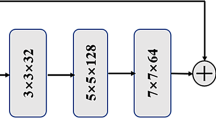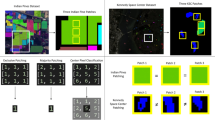Abstract
With the increasing of the forest area and complexity of tree species, collaborative classification using multi-source remote sensing data has been drawn increasing attention. Fusion of hyperspectral and LiDAR data can improve to acquire a comprehensive information which is conductive to the forest land classification. In this work, a similar multi-concentrate network focusing on the fine classification of tree species, denoted as SMCN, is proposed for woodland data. More specific, a preprocessing stage named pixel screening for data intensity critical control is firstly designed. Then, a similar multi-concentrate network is developed to capture spectral and spatial features from hyperspectral and LiDAR data and make specific connections, respectively. Experimental results validated on Belgian data have favorably demonstrated that the proposed SMCN outperforms other state-of-the-art methods.
This work was supported by the National Natural Science Foundation of China under Grants NSFC-91638201, 61922013.
Access this chapter
Tax calculation will be finalised at checkout
Purchases are for personal use only
Similar content being viewed by others
References
Hartling, S., Sagan, V., Sidike, P., Maimaitijiang, M., Carron, J.: Urban tree species classification using a worldview-2\(/\)3 and lidar data fusion approach and deep learning. Sensors 19(6), 1424–8220 (2019)
Huang, G.B., Zhu, Q.Y., Siew, C.K.: Extreme learning machine: theory and applications. Neurocomputing 70(1), 489–501 (2006)
Ioffe, S., Szegedy, C.: Batch normalization: Accelerating deep network training by reducing internal covariate shift. CoRR (2015)
Koetz, B., et al.: Fusion of imaging spectrometer and LIDAR data over combined radiative transfer models for forest canopy characterization. Remot. Sens. Environ. 106(4), 449–459 (2007)
Lee, H., Kwon, H.: Going deeper with contextual CNN for hyperspectral image classification. IEEE Trans. Image Process. 26(10), 4843–4855 (2017)
Liao, W., Coillie, F.V., Gao, L., Li, L., Chanussot, J.: Deep learning for fusion of APEX hyperspectral and full-waveform LiDAR remote sensing data for tree species mapping. IEEE Access 6, 68716–68729 (2018)
Liu, J., Wang, X., Wang, T.: Classification of tree species and stock volume estimation in ground forest images using deep learning. Sensors 166, 0168–1699 (2019)
Luo, S., et al.: Fusion of airborne LIDAR data and hyperspectral imagery for aboveground and belowground forest biomass estimation. Ecol. Indicator. 73, 378–387 (2017)
Maas, A.L., Hannun, A.Y., Ng, A.Y.: Rectifier nonlinearities improve neural network acoustic models. In: 30th ICML, vol. 30, no. 1 (2013)
Tao, R., Zhao, X., Li, W., Li, H.C., Du, Q.: Hyperspectral anomaly detection by fractional Fourier entropy. IEEE J. Sel. Top. Appl. Earth Observat. Remot. Sens. 12(12), 4920–4929 (2019)
Xu, X., Li, W., Ran, Q., Du, Q., Gao, L., Zhang, B.: Multisource remote sensing data classification based on convolutional neural network. IEEE Trans. Geosci. Remot. Sens. 56(2), 937–949 (2018)
Zhao, X., et al.: Joint classification of hyperspectral and LiDAR data using hierarchical random walk and deep CNN architecture. IEEE Trans. Geosci. Remot. Sens. 58, 7355–7370 (2020)
Yokoya, N., Grohnfeldt, C., Chanussot, J.: Hyperspectral and multispectral data fusion: a comparative review of the recent literature. IEEE Geosci. Remot. Sens. Mag. 5(2), 29–56 (2017)
Author information
Authors and Affiliations
Corresponding author
Editor information
Editors and Affiliations
Rights and permissions
Copyright information
© 2020 Springer Nature Switzerland AG
About this paper
Cite this paper
Zhu, Y., Zhang, M., Li, W., Tao, R., Ran, Q. (2020). Collaborative Classification for Woodland Data Using Similar Multi-concentrated Network. In: Peng, Y., et al. Pattern Recognition and Computer Vision. PRCV 2020. Lecture Notes in Computer Science(), vol 12306. Springer, Cham. https://doi.org/10.1007/978-3-030-60639-8_8
Download citation
DOI: https://doi.org/10.1007/978-3-030-60639-8_8
Published:
Publisher Name: Springer, Cham
Print ISBN: 978-3-030-60638-1
Online ISBN: 978-3-030-60639-8
eBook Packages: Computer ScienceComputer Science (R0)




